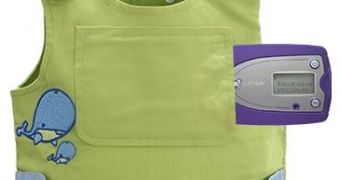A new software allows scientists to analyze young children's vocalizations and determine language learning in familiar environments. It basically helps scientists understand how children develop language and speech by responding to the talk around them. The study also suggests that this method can also detect certain abnormal features, specific to children that develop autism.
Research previous to the study showed that children suffering from Autism Spectrum Disorder have specific articulation and patterns of sound and rhythm. Still, vocal deficiencies were not clearly identified before this study, led by Kim Oller of the University of Memphis in Tennessee.
His team analyzed almost 1,500 recordings of more than 3 million words from 232 children wearing audio recorders in their pockets for a day. The children were aged from 10 months to 4 years and they were typically developed or diagnosed with autism or speech delay. The new software isolated words from cries and separated these utterances in syllables. They established 12 acoustic features linked to movements of the jaw, lips and tongue and vocal quality.
Thanks to this method, scientists found out that with age, all 12 vocal features evolved in typically developing children, while only 2 of these features progressed in autistic children. Another difference between the two categories is given by the structures and the rhythmic features of syllables. All this data was used to establish a model of vocal development that could make the difference between typically developing autistic children.
This new method can be added to all the traditional ways of detecting language disorder and autism, study authors say. It might help early detection and encourage rapid interventions. Gordon Ramsay, a speech scientist at Yale University in New Haven, Connecticut, says that it has been very difficult measuring children's speech problems and quantifying them in order to determine a diagnostic procedure. He adds that “one of the great goals for years now has been to find objective measures of characteristics or behaviors that can be used to diagnose autism. This study is the first application of objective measures to detect autism based on speech.”
Still, scientists like Dorothy Bishop, an expert in developmental language disorders at the University of Oxford, UK are not convinced that this technique will prove very reliable in detecting early signs of autism in children. “They would have to do lot more work showing it could pick up children at risk for autism and distinguish those that developed autism from those that didn't. At the moment, its usefulness is more for research and the theoretical understanding of how children master the ability to speak, than for a clinical application,” she said.
Rhea Paul, an expert in developmental communication disorders at Yale University shares Bishop's opinion: “I don't see this as revolutionizing diagnosis, although it may add a tool to our ability to diagnose children.” she said. “I don't think that parents who are worried about their child's development would be better served by this procedure than by going to a reputable diagnostic facility.”
The study conducted by Kim Oller of the University of Memphis in Tennessee and his team, was published in the Proceedings of the National Academy of Sciences, on Monday.

 14 DAY TRIAL //
14 DAY TRIAL //